Abstract
The actions of intravenous verapamil against arrhythmias induced by occlusion of a coronary artery were investigated in conscious rats. Verapamil (2-20 mg kg-1, i.v. given pre-occlusion) dose-dependently reduced arrhythmias in rats with either large or small occluded zones at an ED50 of 6 mg kg-1. This dose was effective when given immediately post-occlusion. Severe arrhythmias, as opposed to PVC, were preferentially reduced. In conscious, and pentobarbitone-anaesthetized rats, verapamil (6 mg kg-1) had different effects on electrically-induced arrhythmias, and the ECG, from an equi-effective anti-arrhythmic dose of quinidine (20 mg kg-1, i.v.). Quinidine decreased following frequency, but increased threshold current and pulse width, whereas verapamil did not. Both drugs increased P-R interval, but only quinidine increased QRS and Q-T intervals. Thirty minutes post-occlusion, the verapamil content of tissue and blood was determined after a 6 mg kg-1 dose given pre- or post-occlusion. Measurable levels of verapamil were found in both normal and ischaemic myocardium. Plasma and plasma water concentrations were 3.6 +/- 0.8 mumol l-1 and 0.6 +/- 0.1 mumol l-1 (mean +/- s.e. mean), respectively following post-occlusion administration vs. 2.7 +/- 1.2 and 0.24 +/- 0.04 for pre-occlusion administration. Plasma water concentrations were close to IC50 values for inhibition of contractility in rat atria and ventricles. Similar concentrations depressed slow action potentials induced in rat ventricles by raised K+ We suggest that the ability of verapamil to prevent severe ventricular arrhythmias following myocardial ischaemia in the conscious rat is largely due to the calcium antagonist effects of the drug.
Full text
PDF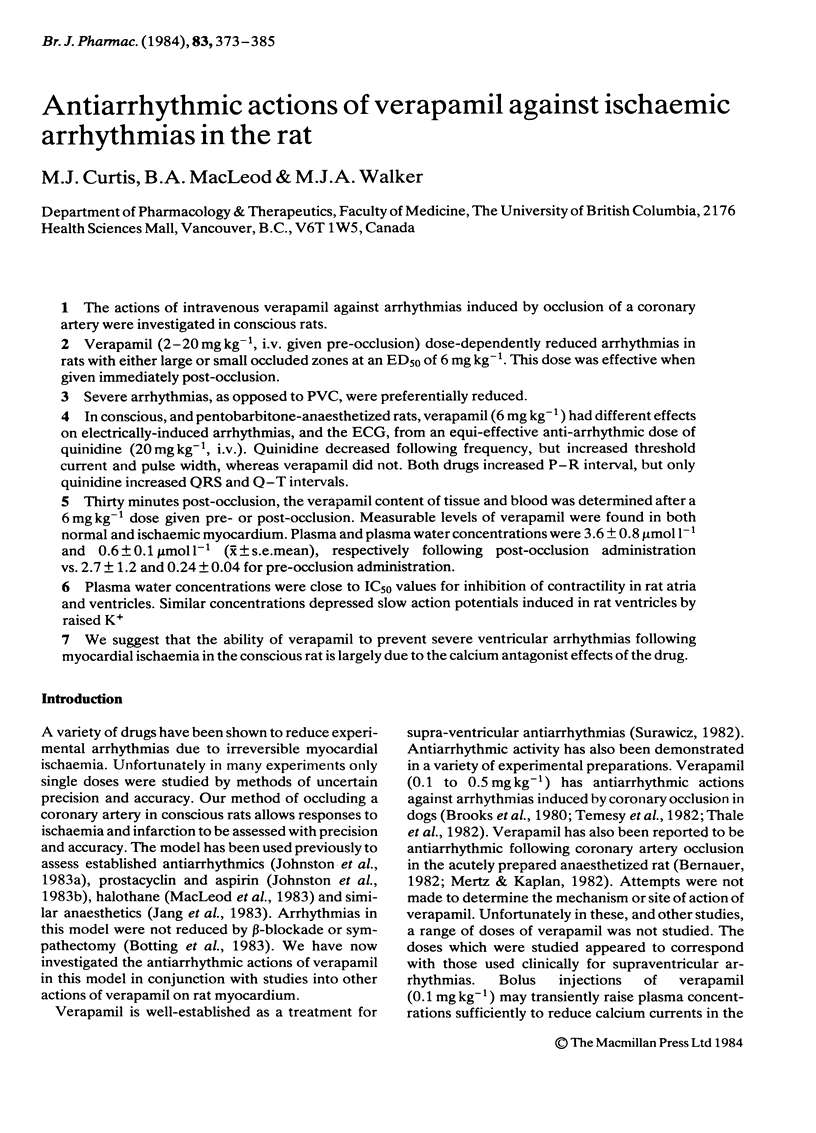
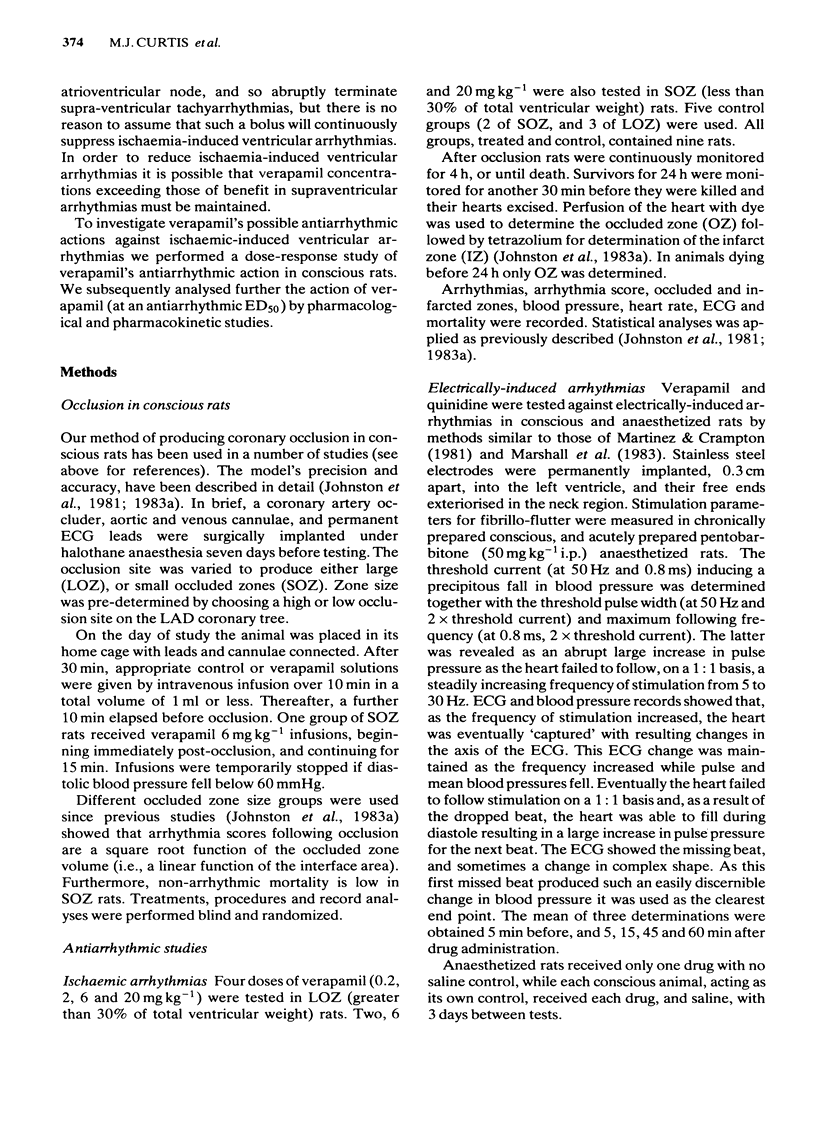
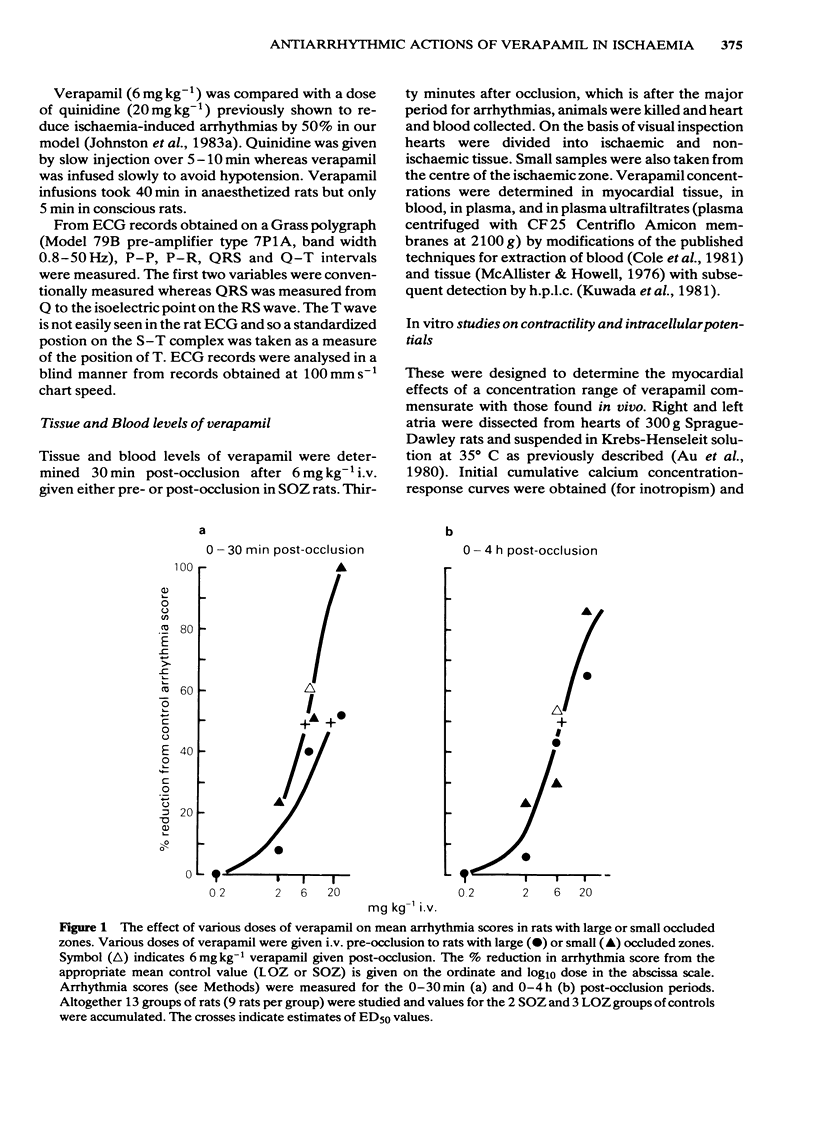
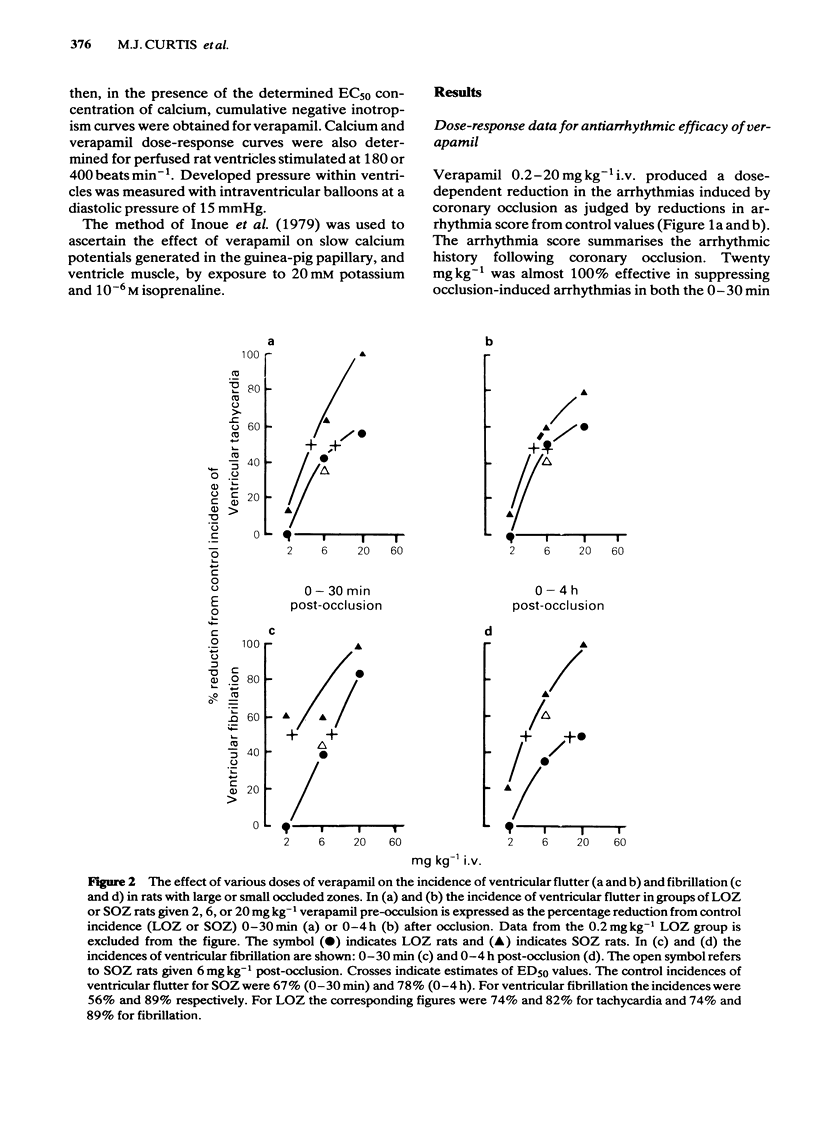
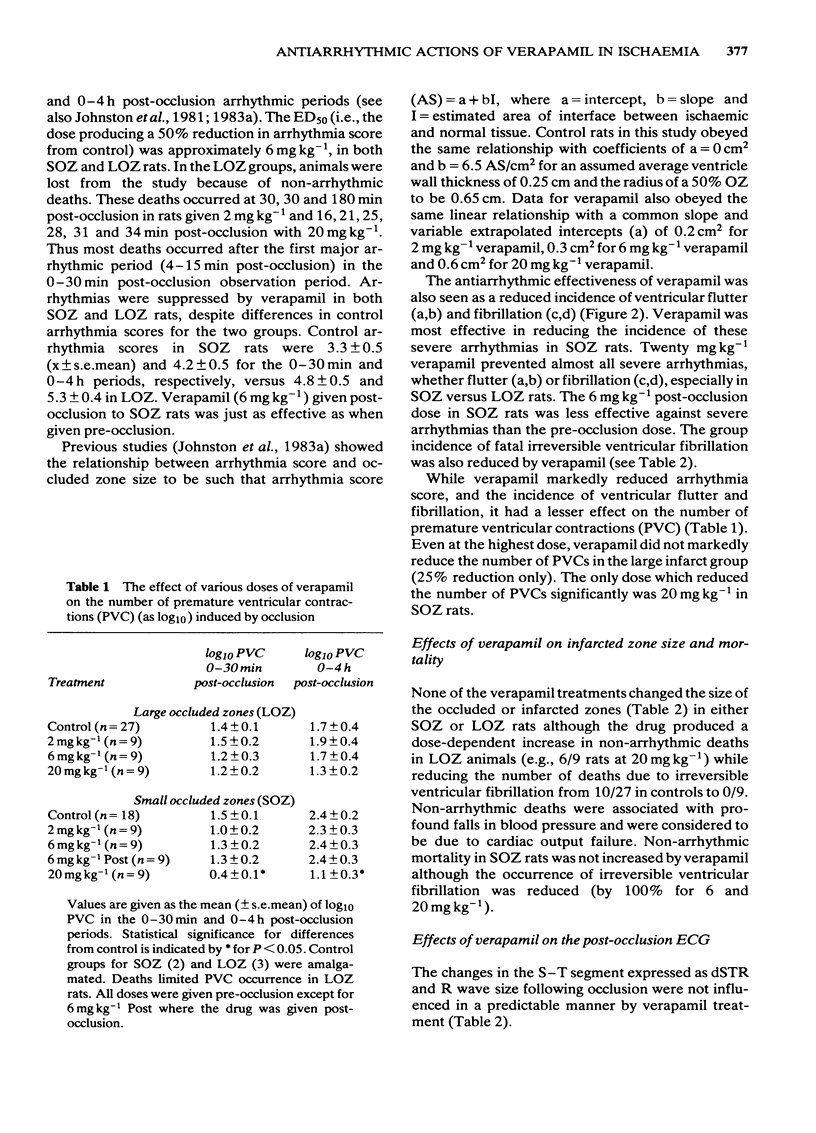
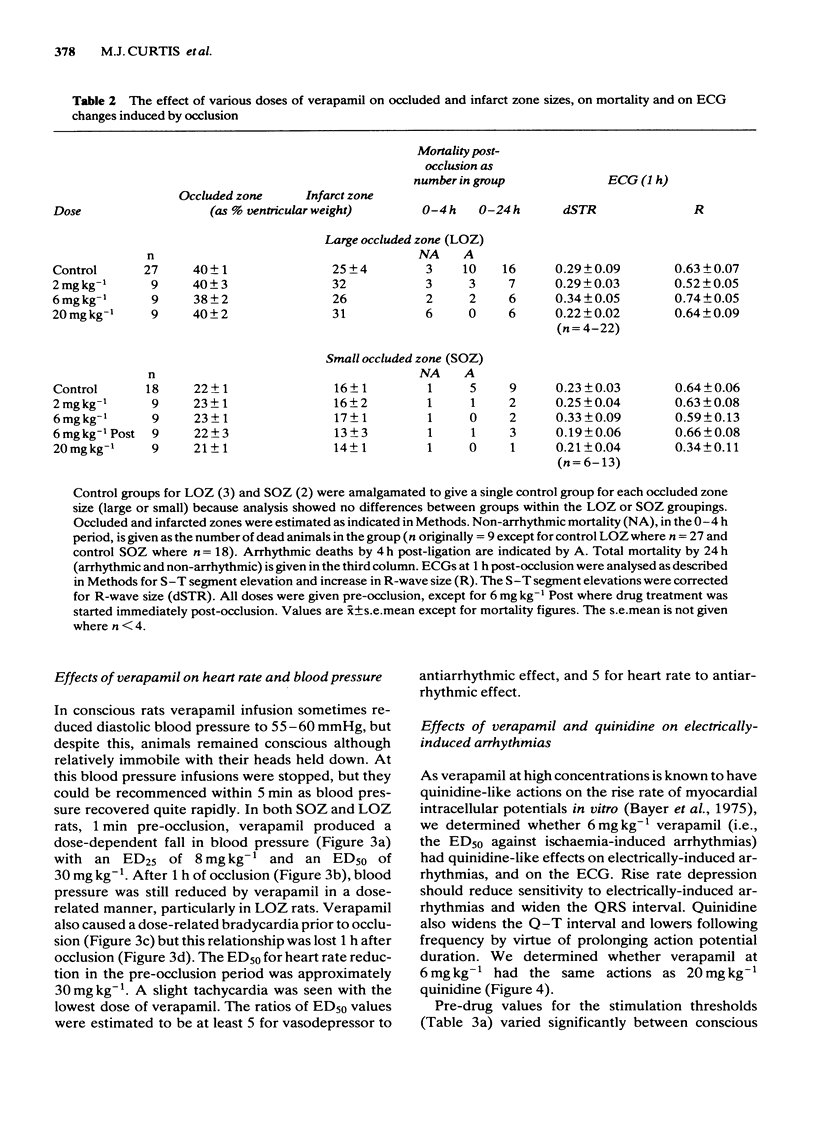

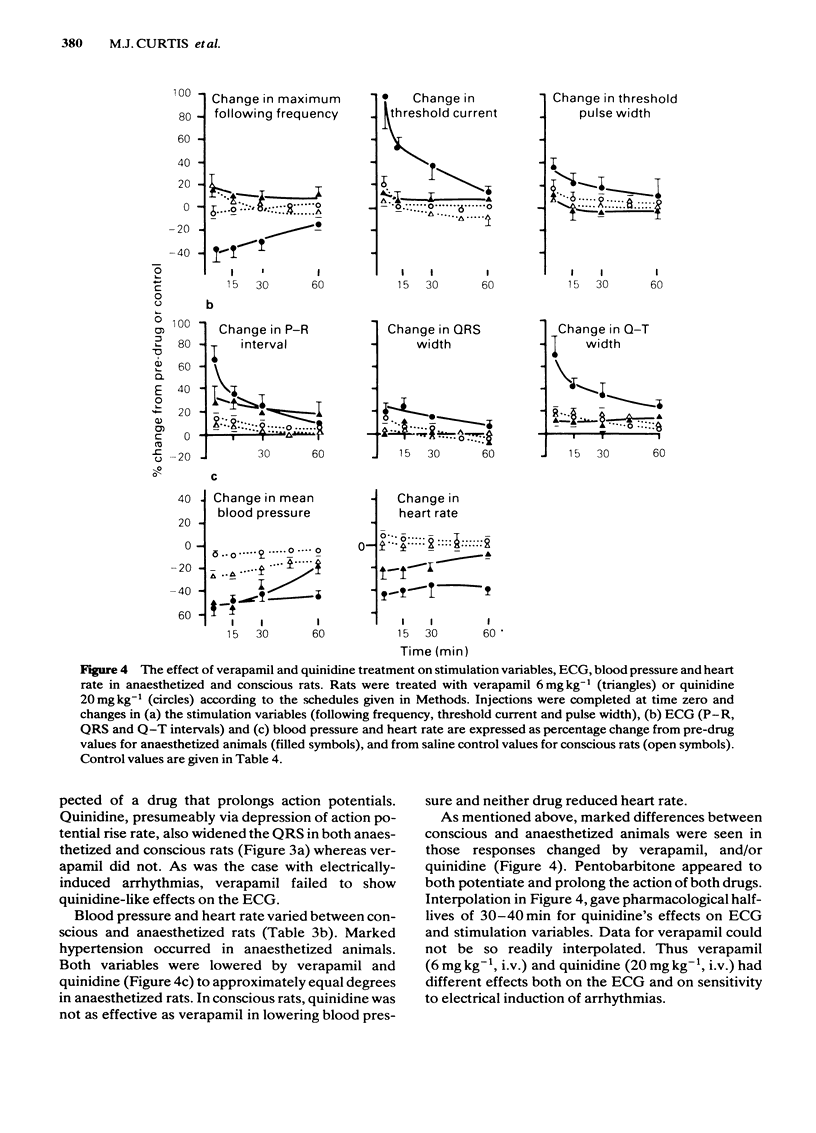
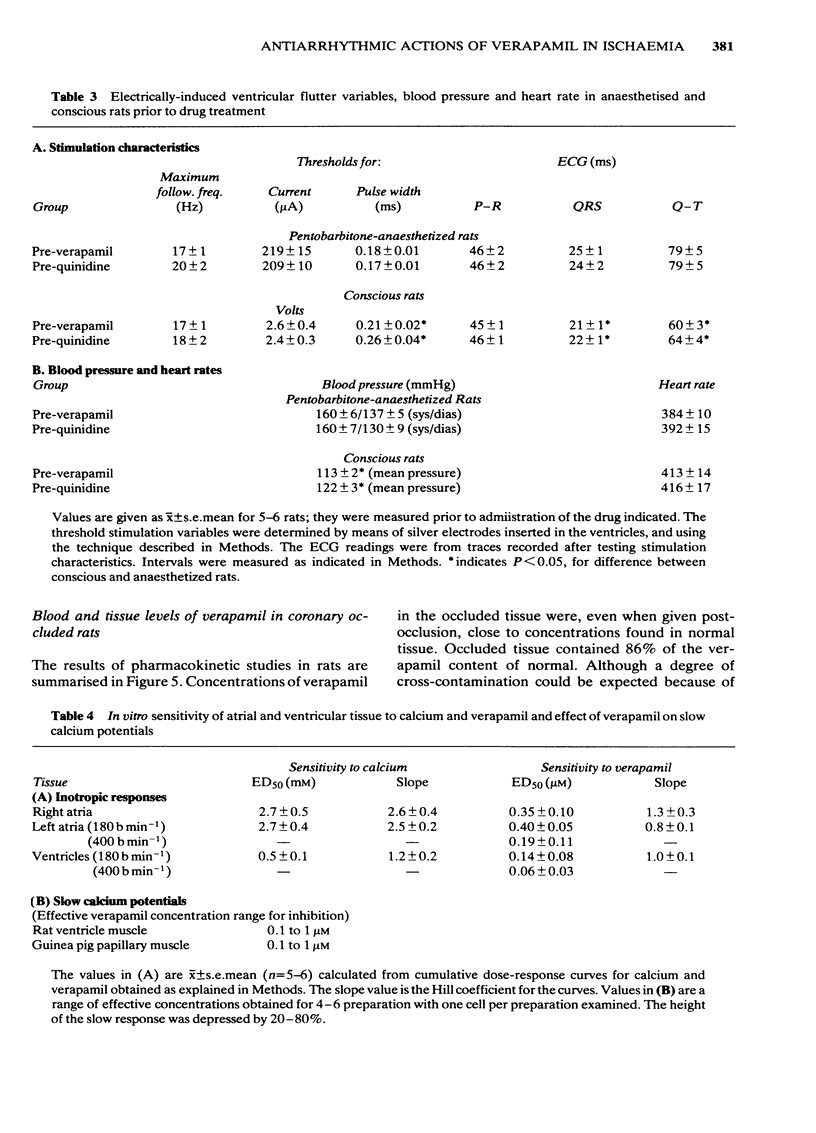
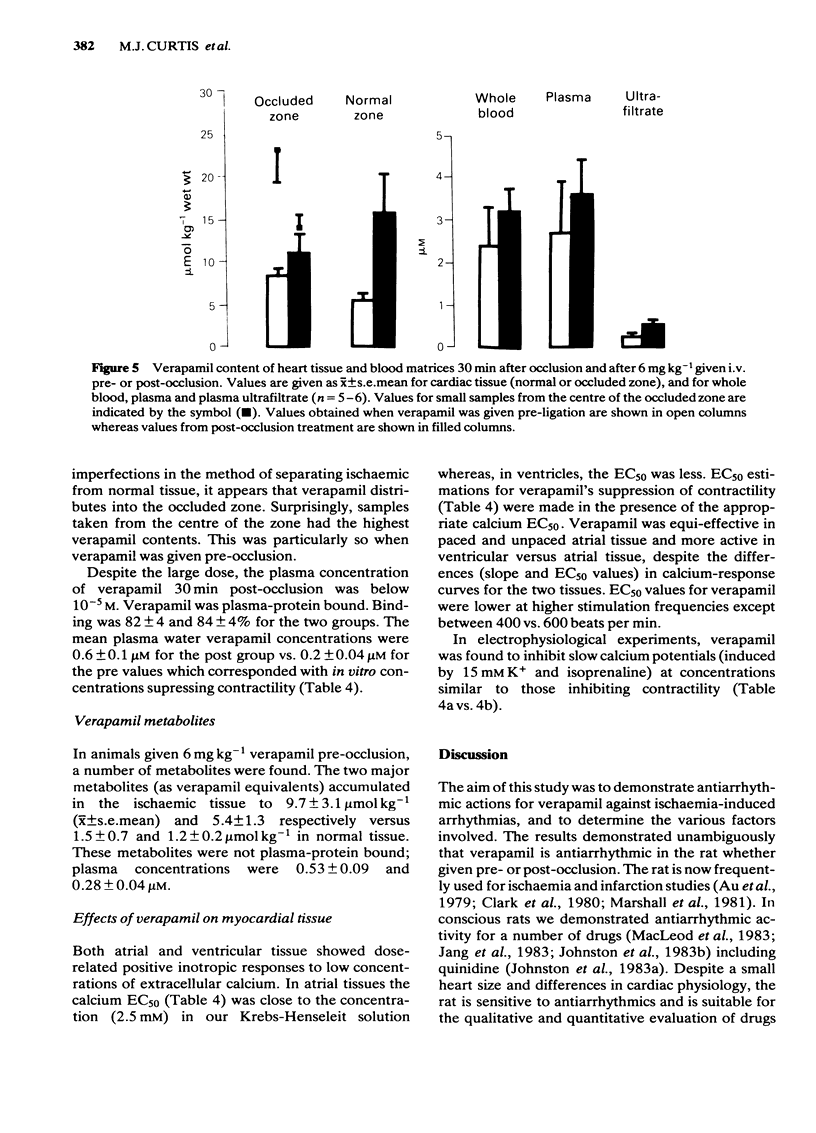
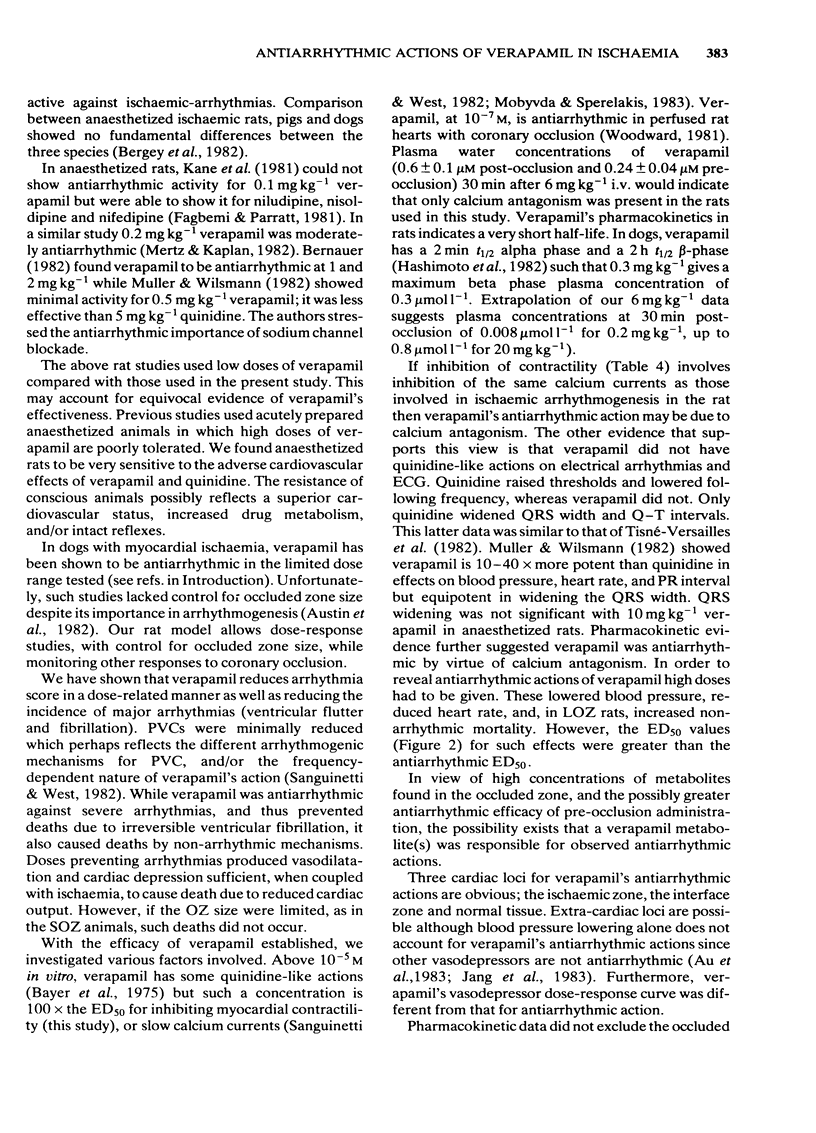
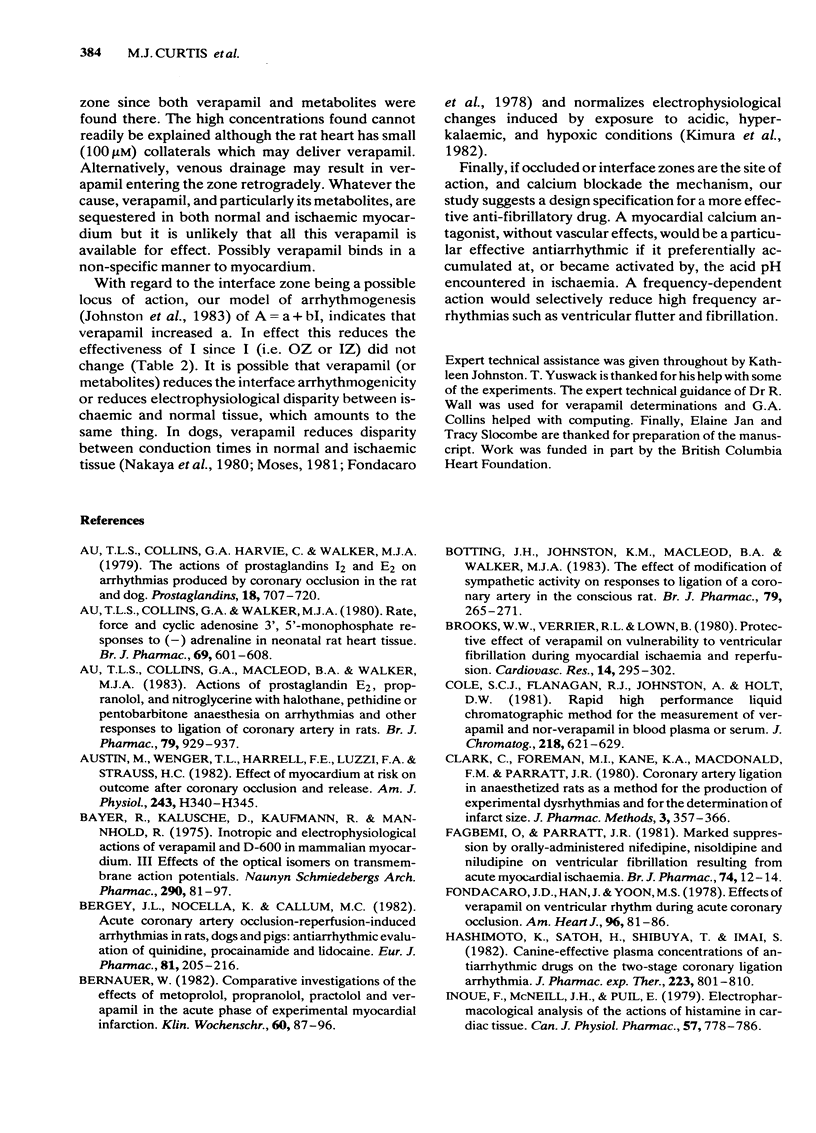
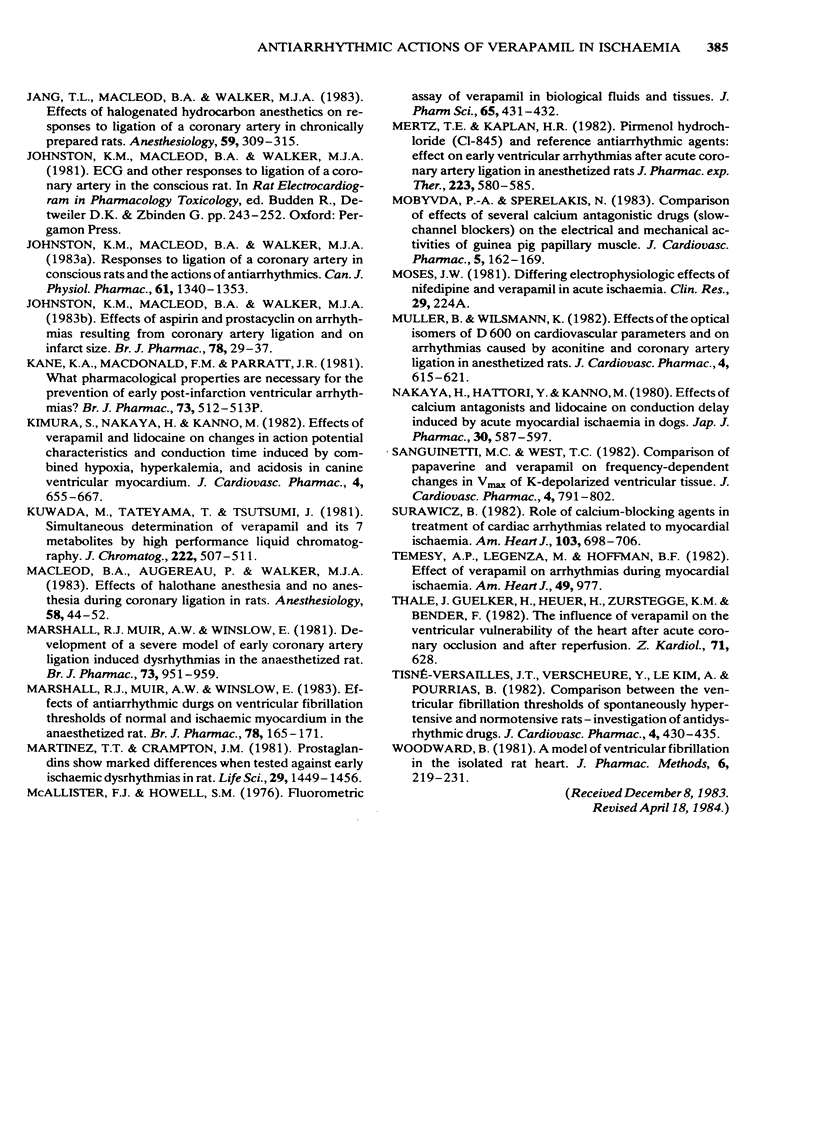
Selected References
These references are in PubMed. This may not be the complete list of references from this article.
- Au T. L., Collins G. A., Harvie C. J., Walker M. J. The actions of prostaglandins I2 and E2 on arrhythmias produced by coronary occlusion in the rat and dog. Prostaglandins. 1979 Nov;18(5):707–720. doi: 10.1016/0090-6980(79)90091-1. [DOI] [PubMed] [Google Scholar]
- Au T. L., Collins G. A., Macleod B. A., Walker M. J. Effects of prostaglandin E2, propranolol and nitroglycerine with halothane, pethidine or pentobarbitone anaesthesia on arrhythmias and other responses to ligation of a coronary artery in rats. Br J Pharmacol. 1983 Aug;79(4):929–937. doi: 10.1111/j.1476-5381.1983.tb10538.x. [DOI] [PMC free article] [PubMed] [Google Scholar]
- Au T. L., Collins G. A., Walker M. J. Rate, force and cyclic adenosine 3',5'-monophosphate responses to (--)-adrenaline in neonatal rat heart tissue. Br J Pharmacol. 1980 Aug;69(4):601–608. doi: 10.1111/j.1476-5381.1980.tb07910.x. [DOI] [PMC free article] [PubMed] [Google Scholar]
- Austin M., Wenger T. L., Harrell F. E., Jr, Luzzi F. A., Strauss H. C. Effect of myocardium at risk on outcome after coronary artery occlusion and release. Am J Physiol. 1982 Aug;243(2):H340–H345. doi: 10.1152/ajpheart.1982.243.2.H340. [DOI] [PubMed] [Google Scholar]
- Bayer R., Kalusche D., Kaufmann R., Mannhold R. Inotropic and electrophysiological actions of verapamil and D 600 in mammalian myocardium. III. Effects of the optical isomers on transmembrane action potentials. Naunyn Schmiedebergs Arch Pharmacol. 1975;290(1):81–97. doi: 10.1007/BF00499991. [DOI] [PubMed] [Google Scholar]
- Bergey J. L., Nocella K., McCallum J. D. Acute coronary artery occlusion-reperfusion-induced arrhythmias in rats, dogs and pigs: antiarrhythmic evaluation of quinidine, procainamide and lidocaine. Eur J Pharmacol. 1982 Jul 9;81(2):205–216. doi: 10.1016/0014-2999(82)90438-1. [DOI] [PubMed] [Google Scholar]
- Bernauer W. Comparative investigation of the effects of metoprolol, propranolol, practolol, and verapamil in the acute phase of experimental myocardial infarction. Klin Wochenschr. 1982 Jan 15;60(2):87–96. doi: 10.1007/BF01716386. [DOI] [PubMed] [Google Scholar]
- Botting J. H., Johnston K. M., Macleod B. A., Walker M. J. The effect of modification of sympathetic activity on responses to ligation of a coronary artery in the conscious rat. Br J Pharmacol. 1983 May;79(1):265–271. doi: 10.1111/j.1476-5381.1983.tb10520.x. [DOI] [PMC free article] [PubMed] [Google Scholar]
- Brooks W. W., Verrier R. L., Lown B. Protective effect of verapamil on vulnerability to ventricular fibrillation during myocardial ischaemia and reperfusion. Cardiovasc Res. 1980 May;14(5):295–302. doi: 10.1093/cvr/14.5.295. [DOI] [PubMed] [Google Scholar]
- Clark C., Foreman M. I., Kane K. A., McDonald F. M., Parratt J. R. Coronary artery ligation in anesthetized rats as a method for the production of experimental dysrhythmias and for the determination of infarct size. J Pharmacol Methods. 1980 Jun;3(4):357–368. doi: 10.1016/0160-5402(80)90077-7. [DOI] [PubMed] [Google Scholar]
- Cole S. C., Flanagan R. J., Johnston A., Holt D. W. Rapid high-performance liquid chromatographic method for the measurement of verapamil and norverapamil in blood plasma or serum. J Chromatogr. 1981 Nov 20;218:621–629. doi: 10.1016/s0021-9673(00)82087-7. [DOI] [PubMed] [Google Scholar]
- Fagbemi O., Parratt J. R. Suppression by orally-administered nifedipine, nisoldipine and niludipine of early, life-threatening ventricular arrhythmias resulting from acute myocardial ischaemia. Br J Pharmacol. 1981 Sep;74(1):12–14. doi: 10.1111/j.1476-5381.1981.tb09949.x. [DOI] [PMC free article] [PubMed] [Google Scholar]
- Fondacaro J. D., Han J., Yoon M. S. Effects of verapamil on ventricular rhythm during acute coronary occlusion. Am Heart J. 1978 Jul;96(1):81–86. doi: 10.1016/0002-8703(78)90129-1. [DOI] [PubMed] [Google Scholar]
- Hashimoto K., Satoh H., Shibuya T., Imai S. Canine-effective plasma concentrations of antiarrhythmic drugs on the two-stage coronary ligation arrhythmia. J Pharmacol Exp Ther. 1982 Dec;223(3):801–810. [PubMed] [Google Scholar]
- Inoue F., McNeill J. H., Puil E., Tenner T. E., Jr Electropharmacological analysis of the actions of histamine in cardiac tissue. Can J Physiol Pharmacol. 1979 Aug;57(8):778–786. doi: 10.1139/y79-121. [DOI] [PubMed] [Google Scholar]
- Jang T. L., MacLeod B. A., Walker M. J. Effects of halogenated hydrocarbon anesthetics on responses to ligation of a coronary artery in chronically prepared rats. Anesthesiology. 1983 Oct;59(4):309–315. doi: 10.1097/00000542-198310000-00007. [DOI] [PubMed] [Google Scholar]
- Johnston K. M., MacLeod B. A., Walker M. J. Effects of aspirin and prostacyclin on arrhythmias resulting from coronary artery ligation and on infarct size. Br J Pharmacol. 1983 Jan;78(1):29–37. doi: 10.1111/j.1476-5381.1983.tb09359.x. [DOI] [PMC free article] [PubMed] [Google Scholar]
- Johnston K. M., MacLeod B. A., Walker M. J. Responses to ligation of a coronary artery in conscious rats and the actions of antiarrhythmics. Can J Physiol Pharmacol. 1983 Nov;61(11):1340–1353. doi: 10.1139/y83-193. [DOI] [PubMed] [Google Scholar]
- Kimura S., Nakaya H., Kanno M. Effects of verapamil and lidocaine on changes in action potential characteristics and conduction time induced by combined hypoxia, hyperkalemia, and acidosis in canine ventricular myocardium. J Cardiovasc Pharmacol. 1982 Jul-Aug;4(4):658–667. doi: 10.1097/00005344-198207000-00019. [DOI] [PubMed] [Google Scholar]
- Kuwada M., Tateyama T., Tsutsumi J. Simultaneous determination of verapamil and its seven metabolites by high-performance liquid chromatography. J Chromatogr. 1981 Mar 13;222(3):507–511. doi: 10.1016/s0378-4347(00)84156-0. [DOI] [PubMed] [Google Scholar]
- MacLeod B. A., Augereau P., Walker M. J. Effects of halothane anesthesia compared with fentanyl anesthesia and no anesthesia during coronary ligation in rats. Anesthesiology. 1983 Jan;58(1):44–52. doi: 10.1097/00000542-198301000-00008. [DOI] [PubMed] [Google Scholar]
- Marshall R. J., Muir A. W., Winslow E. Development of a severe model of early coronary artery ligation-induced dysrhythmias in the anaesthetized rat. Br J Pharmacol. 1981 Aug;73(4):951–959. doi: 10.1111/j.1476-5381.1981.tb08750.x. [DOI] [PMC free article] [PubMed] [Google Scholar]
- Marshall R. J., Muir A. W., Winslow E. Effects of antiarrhythmic drugs on ventricular fibrillation thresholds of normal and ischaemic myocardium in the anaesthetized rat. Br J Pharmacol. 1983 Jan;78(1):165–171. doi: 10.1111/j.1476-5381.1983.tb09377.x. [DOI] [PMC free article] [PubMed] [Google Scholar]
- Martinez T. T., Crampton J. M. Prostaglandins show marked differences when tested against early ischemic dysrhythmias in rat. Life Sci. 1981 Oct 5;29(14):1449–1456. doi: 10.1016/0024-3205(81)90009-6. [DOI] [PubMed] [Google Scholar]
- McAllister R. G., Howell S. M. Fluorometric assay of verapamil in biological fluids and tissues. J Pharm Sci. 1976 Mar;65(3):431–432. doi: 10.1002/jps.2600650330. [DOI] [PubMed] [Google Scholar]
- Mertz T. E., Kaplan H. R. Pirmenol hydrochloride (CI-845) and reference antiarrhythmic agents: effects on early ventricular arrhythmias after acute coronary artery ligation in anesthetized rats. J Pharmacol Exp Ther. 1982 Nov;223(2):580–586. [PubMed] [Google Scholar]
- Molyvdas P. A., Sperelakis N. Comparison of the effects of several calcium antagonistic drugs (slow-channel blockers) on the electrical and mechanical activities of guinea pig papillary muscle. J Cardiovasc Pharmacol. 1983 Jan-Feb;5(1):162–169. doi: 10.1097/00005344-198301000-00025. [DOI] [PubMed] [Google Scholar]
- Müller B., Wilsmann K. Effects of the optical isomers of D 600 on cardiovascular parameters and on arrhythmias caused by aconitine and coronary artery ligation in anesthetized rats. J Cardiovasc Pharmacol. 1982 Jul-Aug;4(4):615–621. doi: 10.1097/00005344-198207000-00013. [DOI] [PubMed] [Google Scholar]
- Nakaya H., Hattori Y., Kanno M. Effects of calcium antagonists and lidocaine on conduction delay induced by acute myocardial ischemia in dogs. Jpn J Pharmacol. 1980 Oct;30(5):587–597. doi: 10.1254/jjp.30.587. [DOI] [PubMed] [Google Scholar]
- Sanguinetti M. C., West T. C. Comparison of papaverine and verapamil on frequency-dependent changes in Vmax of K-depolarized ventricular tissue. J Cardiovasc Pharmacol. 1982 Sep-Oct;4(5):791–802. doi: 10.1097/00005344-198209000-00015. [DOI] [PubMed] [Google Scholar]
- Surawicz B. Role of calcium-blocking agents in treatment of cardiac arrhythmias related to myocardial ischemia. Am Heart J. 1982 Apr;103(4 Pt 2):698–706. doi: 10.1016/0002-8703(82)90476-8. [DOI] [PubMed] [Google Scholar]
- Versailles J. T., Verscheure Y., Le Kim A., Pourrias B. Comparison between the ventricular fibrillation thresholds of spontaneously hypertensive and normotensive rats--investigation of antidysrhythmic drugs. J Cardiovasc Pharmacol. 1982 May-Jun;4(3):430–435. doi: 10.1097/00005344-198205000-00013. [DOI] [PubMed] [Google Scholar]
- Woodward B. A model of ventricular fibrillation in the isolated rat heart. J Pharmacol Methods. 1981 Nov;6(3):219–231. doi: 10.1016/0160-5402(81)90111-x. [DOI] [PubMed] [Google Scholar]


